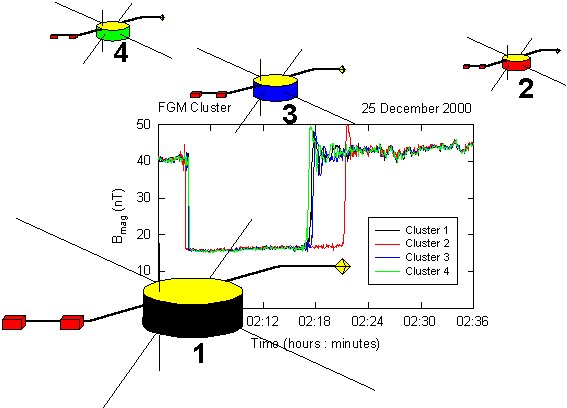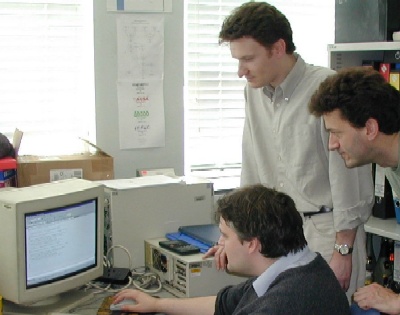
 |
|
News Page |

May 2001 |
This month's news stories:Cluster NewsFrom our Bologna correspondent |
 Measurements from Cluster of the magnitude of the magnetic field strength through two sets of bow shock crossings, showing the bow shock as it first moved fast Earthward over the four Cluster spacecraft, then moved back at a much slower speed.
Measurements from Cluster of the magnitude of the magnetic field strength through two sets of bow shock crossings, showing the bow shock as it first moved fast Earthward over the four Cluster spacecraft, then moved back at a much slower speed.
For ESA's four-spacecraft Cluster mission, and for those of us working with the new observations from our magnetometers onboard the four spacecraft, the past months have been quite hectic. Even though the data recovery from Cluster is limited by the use of a single ground station, starting up the processing and calibration of the magnetic field data has been quite a challenge. At the same time, we have had to learn how to operate the instruments, using the complex procedures devised to ensure the coordinated collection of data from the most interesting parts of the Earth's magnetosphere. But it is clear already that all that effort has been worthwhile. Phenomena in the Earth's complex space environment are seen as they had never been seen before. Making observations on the four spacecraft, separated by only about 600 to 1000 km, shows just how complicated is the space medium around the Earth, and how quickly it responds to small changes in the solar wind!
 | |
The Cluster operations team at Imperial College, Patrick Brown, Chris Carr and Tim Oddy, verify a command sequence to be uplinked to the four spacecraft. |
Six scientific papers have been submitted by group members to the first collection of Cluster papers to appear in Annales Geophysicae, together with more than a dozen other papers (we've simply lost count!) in which we have collaborated. Already new topics are being investigated, several new papers are in preparation. The scientific harvest, as expected, is extremely rich!
André Balogh 10th May 2001
Prof. John Harries, SPAT head of group, recently returned from a few months sabbatical in Bologna, Italy. Here is his third and final report on his activities there, sent just before his return...
Well, our stay in Bologna is almost at an end. By the time you read this, I will probably be back in College at the start of next term.
Some final thoughts? Well, one amazing thing is the river Po and the Po valley and delta. I had no idea before I came what an incredible phenomenon this is. The valley - more properly, the flood plain - is roughly a tall, isosceles triangular shape, on its side. The apex is in the West, somewhere about Turin (home of Juventus), and its base is in the East, on the Adriatic coast between Rimini and Venice. The size of this flood plain is amazing East-West it runs pretty well dead flat for 300km. The base, from Rimini to Venice, is over 100 km. It accounts for much of the flat land in Italy. When we travelled by train from Bologna, on the southern side of the triangle, to Verona, on the north side, our train was travelling for over an hour (and it was a fast train!). And it is all dead flat, flat as a pancake! Farm after farm, village after village, it goes on for a huge distance. E-W it's like travelling from the Welsh coast to beyond London on a single, flat flood plain!
Not only is it huge, it is also amazingly fertile. Over the few months we have been here we have seen the milllions of fruit trees, many trained in 'v shapes' come in to blossom and leaf. The vines have sprouted leaves, and the relatively few fields of cereal or vegetables have grown. The weather helps, of course recently it has alternated between prolonged rain (today it stopped after raining for 36 hours continuously) and hot sunshine.
It has been fascinating being here. I am afraid it has not been entirely the sabbatical rest I would have hoped for, partly because of a number of issues that have followed me from College. Also, I have not finished a fraction of the things I meant to do. But I have been able to think about some questions, and I am very grateful to have had this experience.
About Italy, well, it is full of paradoxes some aspects of life are so well organised compared to Britain, while in other aspects it is amazing that anything gets done! Meetings take forever and rarely seem to follow an agenda, but many things like the buses, the trains, the museums are very well organised. People can be so off-hand, even rude, in public, yet such good friends, and warm family people in private. And so on..... But we have our paradoxes too, in Britain, it's just a different set.
John Harries 12th April 2001
View last month's news, older news or return to Space and Atmospheric Physics home page